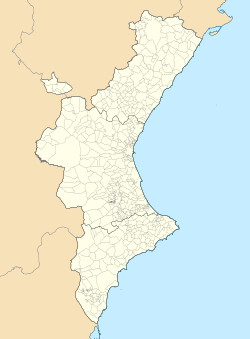Xàtiva facts for kids
Quick facts for kids
Xàtiva
|
|||
|---|---|---|---|

View of Xàtiva
|
|||
|
|||
| Country | |||
| Autonomous community | |||
| Province | |||
| Comarca | Costera | ||
| Judicial district | Xàtiva | ||
| Area | |||
| • Total | 76.56 km2 (29.56 sq mi) | ||
| Elevation | 115 m (377 ft) | ||
| Population
(2018)
|
|||
| • Total | 29,045 | ||
| • Density | 379.376/km2 (982.58/sq mi) | ||
| Demonym(s) | xativí, -ina (Val.) jativés, -esa / setabense (Sp.) |
||
| Time zone | UTC+1 (CET) | ||
| • Summer (DST) | UTC+2 (CEST) | ||
| Postal code |
46800
|
||
| Official language(s) | Spanish and Valencian | ||
Xàtiva (pronounced SHA-tee-va) is a town in eastern Spain. It's located in the province of Valencia, about 25 kilometers (15 miles) west of the Mediterranean Sea. The town sits on the western bank of the Albaida river.
Xàtiva has a very interesting past. During the time of Al-Andalus, when Arabs lived in Spain, they brought the amazing skill of making paper to Xàtiva. This made the town famous for its paper. In the 12th century, Xàtiva was also known for its schools and learning. Later, after Christian kingdoms took back control, Xàtiva became the home of a very powerful family called the House of Borgia. Two members of this family even became Popes: Callixtus III and Alexander VI.
History of Xàtiva
Xàtiva was known as Saetabis in ancient Roman times. It was famous for its fine linen fabrics, which were even mentioned by famous Roman poets. But Xàtiva is perhaps most famous for being one of the first places in Europe to make paper. In the 12th century, Arabs brought the special technology for making paper to Xàtiva.
This town is also the birthplace of two Popes, Callixtus III and Alexander VI. A famous painter named José Ribera, also known as Lo Spagnoletto, was also born here.
Xàtiva faced a very difficult time in its history. During a war called the War of the Spanish Succession, King Philip V of Spain attacked the city. After winning the Battle of Almansa, he ordered Xàtiva to be burned down and renamed San Felipe. To remember this unfair act, a portrait of King Philip V hangs upside down in the local museum, the Museum of l'Almodí. It's a way for the people of Xàtiva to show how they felt about what he did.
For a short time in 1822, Xàtiva was even the capital of its own Province of Xàtiva. This happened during a period when Spain was trying out new ways of governing. However, this change didn't last long, and the province was removed in 1823.
What to See in Xàtiva
Xàtiva is built on the side of a green plain. It sits on the northern slopes of a hill called Monte Vernissa. This hill has two peaks, and on top of them, you can see the impressive Xativa Castle.
Some of the main places to visit include:
- The Collegiate Basilica of Xàtiva: This large church was first built in 1414. It was rebuilt about a hundred years later in a beautiful Renaissance style. It used to be a cathedral and is one of the most important churches in the town.
- The town hall: Parts of this building, and a church on the castle hill, are made from old Roman stones with carvings.
- Old Moorish houses: Several houses in Xàtiva date back to the time when Moors lived here.
- Royal Monastery of the Assumption: This monastery combines Gothic and Baroque styles. It was built in the 14th century and updated between the 16th and 18th centuries.
- Natal house of Alexander VI: You can visit the house where Pope Alexander VI was born.
- Sant Feliu, Xàtiva (St Felix): This church was built in the 13th century.
- Sant Pere, Xàtiva (St Peter): This 14th-century church has a special ceiling inside. It's decorated in a Gothic-Mudéjar style, which mixes Christian and Islamic art.
- Hermitage of Santa Anna: This small chapel from the 15th century is built in the Gothic style.
- Almodí: This Gothic building from the 14th century (built between 1530 and 1548) is now a museum. This is where you can see the upside-down portrait of King Philip V.
- Casa de l'Ensenyança, Xàtiva: This is a center for education.
- Sant Francesc, Xàtiva: Another important church in Xàtiva.
- Village of Anahuir: A small village nearby.
Famous People from Xàtiva
Many notable people have come from Xàtiva, including:
- Abu al-Qasim al-Shatibi (1144–1194 CE)
- Abu Ishaq al-Shatibi (1320–1388 CE)
- Pope Calixtus III (1378–1458)
- Pope Alexander VI (1431–1503)
- Tomás Cerdán de Tallada (1530–1614)
- Diego Ramírez de Arellano (1580–1624)
- Jusepe de Ribera (1591–1652)
- Jaime Villanueva (1765–1824)
- Raimon (born 1940)
- Joan Ramos (born 1942)
- Toni Cucarella (born 1959)
- Feliu Ventura (born 1976)
Images for kids
-
The portrait of Philip V of Spain hanging upside down in the Museum of Almodí.
See also
 In Spanish: Játiva para niños
In Spanish: Játiva para niños












